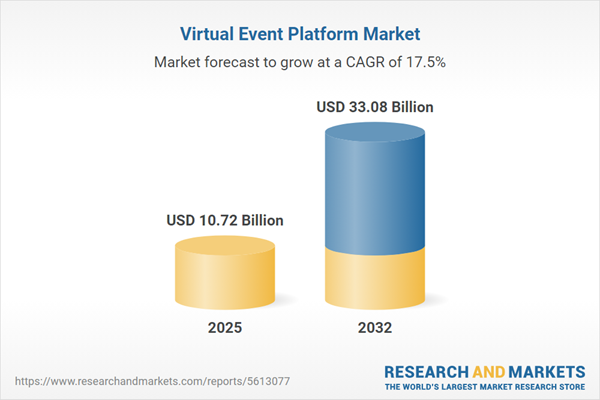Speak directly to the analyst to clarify any post sales queries you may have.
Virtual event platforms are rapidly becoming indispensable for global organizations striving to enhance engagement and foster seamless connectivity among diverse professional audiences. As remote collaboration and digital-first strategies gain traction, these platforms facilitate content delivery, networking, and actionable insights across industries, reshaping how enterprises host events and drive outcomes.
Market Snapshot: Virtual Event Platform Market Size and Growth
The Virtual Event Platform Market grew from USD 9.09 billion in 2024 to USD 10.72 billion in 2025. It is expected to continue growing at a CAGR of 17.51%, reaching USD 33.08 billion by 2032. Rising demand for scalable event solutions, increased digital transformation, and cross-industry adoption are key drivers of this upward trend.
Scope & Segmentation
This comprehensive report provides detailed market coverage, evaluating emerging opportunities, trends, and technology adoption across the value chain. Segmentation analysis allows decision-makers to tailor strategies to fast-evolving customer and market needs.
- Event Types: Conferences & Trade Shows, Hybrid Events, Webinars, Workshops & Training
- Component: Services (Managed, Professional, Support), Solutions (Analytics Tools, Content Management, Engagement Tools, Platform Software)
- Application: Corporate Communications, Marketing & Lead Generation, Product Launch, Recruitment & HR, Training & Education
- Industry Verticals: BFSI, Education, Government & Defense, Healthcare, IT & Telecom, Retail & E-Commerce
- Organization Size: Large Enterprises, Small and Medium Enterprises
- Pricing Model: Freemium, Pay As You Go, Subscription
- Geographic Coverage: Americas (United States, Canada, Mexico, Brazil, Argentina, Chile, Colombia, Peru), Europe, Middle East & Africa (UK, Germany, France, Russia, Italy, Spain, Netherlands, Sweden, Poland, Switzerland, UAE, Saudi Arabia, Qatar, Turkey, Israel, South Africa, Nigeria, Egypt, Kenya), Asia-Pacific (China, India, Japan, Australia, South Korea, Indonesia, Thailand, Malaysia, Singapore, Taiwan)
- Company Profiles: Zoom Video Communications, Cisco Systems, Cvent, ON24, Eventbrite, Hopin, Bizzabo, vFairs, 6Connex, Brella
Key Takeaways: Virtual Event Platform Market
- Market evolution reflects a shift from basic webinar tools to multi-featured ecosystems integrating analytics, AI, and hybrid functionalities.
- Hybrid models unlock new revenue channels by blending physical presence with digital access, enabling greater reach for organizers.
- Personalized and immersive event experiences now drive platform adoption, as participants expect engagement tools such as live networking and real-time content customization.
- Competition centers on delivering extensible solutions, with strategic partnerships and open APIs facilitating seamless integration into enterprise technology stacks.
- Security and compliance, including certifications like SOC 2 and ISO 27001, represent essential differentiators for platforms targeting regulated industries.
- Flexible pricing models and regional partnerships help providers capture growth within diverse client segments and maintain relevance with shifting budgets.
Tariff Impact on the Virtual Event Platform Industry
Recent United States tariffs have impacted procurement for hardware and infrastructure components, driving suppliers to adapt cost structures and explore domestic sourcing. These changes affect pricing and strategic planning for operators and event organizers, influencing market dynamics through 2025 and encouraging supply chain realignment and local investment.
Methodology & Data Sources
This report utilizes a mixed methods approach, combining extensive desk research, structured quantitative surveys, and in-depth qualitative interviews with industry executives. Data triangulation and expert advisory panels ensure robust validation of market patterns, regulatory factors, and innovation trajectories.
Why This Report Matters
- Supports strategic decisions by providing actionable insights on shifting user expectations, competitive differentiation, and growth opportunities in the virtual event platform market.
- Addresses the impact of industry trends, regulatory updates, and technology adoption, allowing leaders to align investments and partnerships for sustained value.
- Guides executive teams in navigating tariff implications, platform selection, and adoption strategies aligned with evolving organizational priorities.
Conclusion
Adoption of virtual event platforms has become central to delivering impactful engagement and operational agility. This report equips decision-makers with the intelligence needed to optimize event strategies and remain competitive in a fast-transforming landscape.
Additional Product Information:
- Purchase of this report includes 1 year online access with quarterly updates.
- This report can be updated on request. Please contact our Customer Experience team using the Ask a Question widget on our website.
Table of Contents
3. Executive Summary
4. Market Overview
7. Cumulative Impact of Artificial Intelligence 2025
Companies Mentioned
The companies profiled in this Virtual Event Platform market report include:- Zoom Video Communications, Inc.
- Cisco Systems, Inc.
- Cvent, Inc.
- ON24, Inc.
- Eventbrite, Inc.
- Hopin Ltd.
- Bizzabo, Inc.
- vFairs Inc.
- 6Connex LLC
- Brella Oy
Table Information
| Report Attribute | Details |
|---|---|
| No. of Pages | 195 |
| Published | October 2025 |
| Forecast Period | 2025 - 2032 |
| Estimated Market Value ( USD | $ 10.72 Billion |
| Forecasted Market Value ( USD | $ 33.08 Billion |
| Compound Annual Growth Rate | 17.5% |
| Regions Covered | Global |
| No. of Companies Mentioned | 11 |









